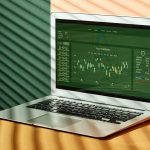What is the Ichimoku cloud chart?
Ichimoku cloud chart, also known as Ichimoku Kinko Hyo, is a technical analysis tool developed in Japan. It is used to identify trend direction, support and resistance levels, and potential price targets. The Ichimoku cloud chart consists of five lines: the Tenkan Sen (red), the Kijun Sen (blue), the Chikou Span (green), the Tenkan Sen line crossing the Kijun Sen line to form a “T” signal (bullish crossover), and the KijunSen line crossing the Chikou Span line to create an “L” signal (bearish crossover).
How to use Ichimoku cloud charts
The Ichimoku cloud chart can be used to identify the following:
- The trend direction
- Support and resistance levels
- Price targets
- The strength of the trend
- When to buy or sell
How to interpret the Ichimoku cloud chart
The Ichimoku cloud chart is interpreted by looking at the following:
- The Tenkan Sen line: This line is used to identify the short-term trend and is calculated by taking the median of the high and low prices over a given period. The Tenkan Sen line is also known as the conversion line.
- The Kijun Sen line is used to identify the long-term trend and is calculated by taking the median of the high and low prices over a given period. The Kijun Sen line is also known as the baseline.
- The Chikou Span: This line plots yesterday’s price relative to today’s price and is used to identify support and resistance levels.
- The Tenkan Sen line crosses the Kijun Sen line to form a “T” signal (bullish crossover): This signals that the short-term trend is bullish and time to buy.
- The KijunSen line crosses the Chikou Span line to form an “L” signal (bearish crossover): This signals that the long-term trend is bearish and time to sell.
How to use Ichimoku cloud charts in trading?
The Ichimoku cloud chart can be used in trading by looking for signals such as the Tenkan Sen line crossing the Kijun Sen line to form a “T” signal (bullish crossover) or the KijunSen line crossing the Chikou Span line to create an “L” signal (bearish crossover). These signals can be used to enter into a trade. For example, if the Tenkan Sen line crosses the Kijun Sen line to form a “T” signal, this would be a bullish signal, and it would be time to buy. Similarly, if the KijunSen line crossed the Chikou Span line to form an “L” signal, this would be a bearish signal, and it would be time to sell. Traders can also use these signals to set price targets.
The importance of Ichimoku cloud chart in trading
Ichimoku cloud charts are essential because they help traders identify the current trend by showing the direction of prices. They also offer support and resistance levels, potential entry points, and possible exit points. It helps traders improve their risk-reward ratio or determine when to cut losses.
Ichimoku cloud charts are technical analysis tools developed in Japan that help traders identify the current trend, support and resistance levels, possible entry points, and possible exit points.
It consists of five lines:
the Tenkan Sen (red), the Kijun Sen (blue), the Chikou Span (green), the Tenkan Sen line crossing the Kijun Sen line to form a “T” signal (bullish crossover), and the KijunSen line crossing the Chikou Span line to create an “L” signal (bearish crossover). They can be used by looking for signals such as the Tenkan Sen line crossing the Kijun Sen line to form a “T” signal or the KijunSen line crossing the Chikou Span line to create an “L” signal. Traders can also use them in trading by looking at directional movement, support and resistance levels, and price targets.
In conclusion
Ichimoku cloud charts are technical analysis tools developed in Japan that help traders identify the current trend and support and resistance levels.






